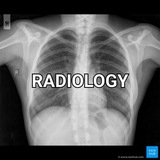Radiology
Answers
Luxatio erecta is also known as inferior
dislocation of shoulder.
◦ This is caused due to severe hyperabduction
◦ The radiograph shows head of humerus is
present below glenoid and the shaft is in
abducted position.
dislocation of shoulder.
◦ This is caused due to severe hyperabduction
◦ The radiograph shows head of humerus is
present below glenoid and the shaft is in
abducted position.
Radiology
Identify the correct statement based on the given radiograph.
Radiology
Answers of the radiograph.
◦ The above radiograph shows supracondylar fracture of humerus
• Displaced supracondylar fracture of humerus can damage median nerve causing pointing
index sign.
• Its common complication is cubitus varus deformity (Gun stock deformity) due to the
malunion of fractured ends.
◦ Myositis ossificans is a delayed
complication of the fracture.
• Displaced supracondylar fracture of humerus can damage median nerve causing pointing
index sign.
• Its common complication is cubitus varus deformity (Gun stock deformity) due to the
malunion of fractured ends.
◦ Myositis ossificans is a delayed
complication of the fracture.
Double PCL sign on MRI is seen in
Anonymous Quiz
19%
A.PCL tear
41%
B. Medial meniscal tear
35%
C. Tear of lateral collateral ligament
6%
D. Fracture patella
Radiology
Double PCL sign on MRI is seen in
The double PCL sign appears on sagittal MRI
images of the knee when a bucket-
handle meniscal tear (medial meniscus in 80%
of cases) flips towards the centre of the joint so
that it comes to lie anteroinferior to
the posterior cruciate ligament (PCL) mimicking
a second smaller PCL.
images of the knee when a bucket-
handle meniscal tear (medial meniscus in 80%
of cases) flips towards the centre of the joint so
that it comes to lie anteroinferior to
the posterior cruciate ligament (PCL) mimicking
a second smaller PCL.
*It’s official #NEETPG2025 - Postponed indefinitely!*
https://natboard.edu.in/viewNotice.php?NBE=b3dsNS9TcHUwUFo5cFFRMmZ4eENkUT09
*Join for All Updates* 👇 👇
https://whatsapp.com/channel/0029Va5uYgUKGGGNpDS2LJ2X
https://natboard.edu.in/viewNotice.php?NBE=b3dsNS9TcHUwUFo5cFFRMmZ4eENkUT09
*Join for All Updates* 👇 👇
https://whatsapp.com/channel/0029Va5uYgUKGGGNpDS2LJ2X
11. The CT severity index in acute pancreatitis is described by:
Anonymous Quiz
67%
a) Balthazar
24%
b) Mengini c) Chapman
9%
d) Napelon
Mark here guys
Sorry for disturbance
B and c are together there by mistake
Sorry for disturbance
B and c are together there by mistake
Anonymous Poll
65%
A
20%
B
12%
C
3%
D
Radiology
11. The CT severity index in acute pancreatitis is described by:
Correct Answer- A
The CT severity index (CTSI)-described by Balthazar
Balthazar CT Severity Index
CT Grade
Score
eA. Normal-O
. B. Enlarged gland -1
. C. Peri-pancreatic inflammation- 2
.D. One fluid collection- 3
◦ E. Two or more collections-4
Necrosis Score
.
.30%-50%- (4)
.[>50% -(6)
Ref: ACR Appropriateness Criteria,Acute Pancreatitis.
The CT severity index (CTSI)-described by Balthazar
Balthazar CT Severity Index
CT Grade
Score
eA. Normal-O
. B. Enlarged gland -1
. C. Peri-pancreatic inflammation- 2
.D. One fluid collection- 3
◦ E. Two or more collections-4
Necrosis Score
.
.30%-50%- (4)
.[>50% -(6)
Ref: ACR Appropriateness Criteria,Acute Pancreatitis.
The CT severity index in acute pancreatitis is
Anonymous Quiz
64%
a) Balthazar
14%
b) Mengini
14%
c) Chapman
8%
d) Napelon
Radiology
The CT severity index in acute pancreatitis is
Correct Answer- A
The CT severity index (CTSI)-described by Balthazar
Balthazar CT Severity Index
CT Grade
Score
◦ A. Normal-
.B Enlarged gland -1
. C. Peri-pancreatic inflammation-2
. D. One fluid collection- 3
. E. Two or more collections- 4
Necrosis Score
◦
.|30%-50%- (4)
.| >50% -(6)
Ref: ACR Appropriateness Criteria,Acute Pancreatitis
The CT severity index (CTSI)-described by Balthazar
Balthazar CT Severity Index
CT Grade
Score
◦ A. Normal-
.B Enlarged gland -1
. C. Peri-pancreatic inflammation-2
. D. One fluid collection- 3
. E. Two or more collections- 4
Necrosis Score
◦
.|30%-50%- (4)
.| >50% -(6)
Ref: ACR Appropriateness Criteria,Acute Pancreatitis
Empty thecal sac sign on MRI is
seen in:
seen in:
Anonymous Quiz
34%
A. Arachnoiditis
12%
B. Discitis
33%
C. vertebral osteomyelitis
21%
D. Tethered cord syndrome
Forwarded from Microbiology
Operculated eggs are seen in
Anonymous Quiz
27%
a) Nematodes
28%
b) Cestodes
40%
c) Trematodes
6%
d) Protozoa
Radiology
Empty thecal sac sign on MRI is
seen in:
seen in:
Empty thecal sac sign is seen in arachnoiditis.
Due to inflammation, there is clumping of nerve
roots and thecal sac appears empty on MRI of a
lumbar spine.
Due to inflammation, there is clumping of nerve
roots and thecal sac appears empty on MRI of a
lumbar spine.
Best view for right lung
Anonymous Quiz
33%
A. Right anterior oblique
20%
B. Left anterior oblique
39%
C. Right Posterior oblique
8%
D. Left posterior oblique
Radiology
Best view for right lung
Best view for right lung is left anterior
oblique. For left lung it is right anterior oblique
Both these views are also used in coronary
angiography.
◦ Left anterior oblique view demonstrates the
maximum area of right lung field. However
left anterior oblique view is mainly used for
assessment of left and right ventricles, left
atrium and aortic window and aorta.
◦ Right anterior oblique view demonstrates the
maximum area of the left lung field. It is used
for assessment of pulmonary artery, right
ventricle and size of the left atrium.
oblique. For left lung it is right anterior oblique
Both these views are also used in coronary
angiography.
◦ Left anterior oblique view demonstrates the
maximum area of right lung field. However
left anterior oblique view is mainly used for
assessment of left and right ventricles, left
atrium and aortic window and aorta.
◦ Right anterior oblique view demonstrates the
maximum area of the left lung field. It is used
for assessment of pulmonary artery, right
ventricle and size of the left atrium.
